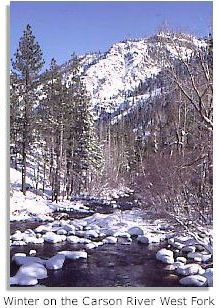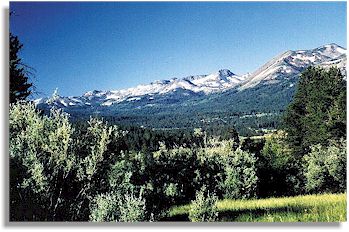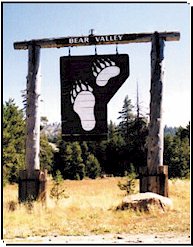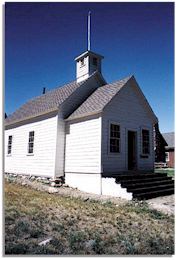ALPINE COUNTY, CALIFORNIA GENWEB PROJECT
|
Alpine County Information |
|
Alpine County was created from parts of Amador, El Dorado, Calaveras, Tuolumne and Mono Counties in 1864. Alpine County, California lies along the crest of the central Sierra Nevada, south of Lake Tahoe and north of Yosemite. Its name truly describes the area, since rugged snow-covered peaks, high alpine meadows laced with clear mountain streams and beautiful forest are the main geographic features. El Dorado, Amador, Calaveras, Tuolumne and Mono Counties in California and Douglas County in Nevada all border Alpine County. The main routes in Alpine County are State Highways 88, 89 and 4. Alpine County has the smallest population of all counties in California (about 1,190 people in 2004). Most of the population is concentrated around a few mountain communities: Markleeville, Woodfords, Bear Valley and Kirkwood. Residents enjoy a rural lifestyle and the convenience of several cities in the neighboring counties. Markleeville is the county seat and home to many of the county's offices. Since Alpine County has no incorporated cities, most public services are provided by county departments and agencies. Nowhere in this entire county will you find a high school football game or a basketball game on a Saturday night. Nor will you find news of a high school prom. In this county, kids don't get to eat a Big Mac, hang out at a convenience store, or go to see a movie in a theater. Even if they wanted to do so, patients could not get their teeth cleaned professionally in this county. Alpine County has no high schools, fast food restaurants, convenience stores, or theaters - no hospitals, no dentists, no resident physicians, no supermarkets, no malls, no automobile service stations and not even a single traffic light. Alpine County is the only county in all of California that does not have a single bank or ATM in it. The entire county is tied together by one road that passes over Ebbett's Pass, elevation 8,730 feet. The pass is closed and impassable during winter months and winters sometimes last up to six months. Those residents on the west side of the split county generally head to Calaveras County or Tuolumne County to obtain services. Those residents on the east side of the county generally visit Douglas County, Nevada, to obtain services. At 776 square miles, Alpine County is the eighth smallest of California's 58 counties, but it ranks first in the state for the smallest population. Official census numbers for 2004 indicated that 1,190 people resided in the county year-round. However, that number probably was drastically incorrect, since locals report that at least 1/3 of Alpine County's residents do not live there through the winter months. Markleeville (elevation 5,500; population 165) is on the west side of the pass and is the county seat. Students attend high school in the next county, which is Douglas, in the State of Nevada. In fact, many residents do most things in Nevada. Locals tend to think of Nevada as "downtown" or "down the hill". They listen to Nevada radio stations and watch "local" television programs out of Reno, Nevada. The Sacramento Bee newspaper is delivered in Alpine County, but nearly every resident reads the Record Courier, which is the daily newspaper from Minden, Nevada. Some locals fervently wish that Alpine County was part of the State of Nevada, rather than the State of California. In 1861, Jacob Marklee homesteaded 160 acres in the town that became his namesake. He built a road through it, set up a toll station and collected money from the wagon trains that passed through his town. Wagon masters willingly paid those settlers who laid roads for them. There was at least one person, however, that was not willing to pay. Marklee's enterprise ended when an unknown individual murdered him by taking an axe to his head. Silver mines boomed in the area in the 1850s, which was the cause of the county's creation in the first place, since people needed a place to file mining claims. Alpine County's population peaked in the 1860s at approximately 5,000 people, mainly supported by mining, logging and ranching. Though the logging industry held out longer than the silver, the logging eventually came to a halt when politicians and environmentalists began objecting to logging practices. While some ranches still exist in the county, tourism and county government primarily support the county today.
There are no sidewalks in Markleeville. The Cutthroat Saloon, part of the Alpine Hotel in Markleeville, was moved, board by board, from some unknown place in 1886. Many of its original square nails still hold the building together. Despite its limitations, residents of Alpine County are quite content in their relaxed rural lifestyle, even boasting about the county's lack of facilities. Today, most of the county's income is derived from visitors that arrive from the booming tourism communities of Lake Tahoe and western Nevada, who seek out the county for its rich outdoor recreation. Fishing, camping, hiking, rafting, skiing and other winter snow sports all contribute to an economy that is dependent upon tourism. Alpine County's northern region is a land of contrasts, from the alpine peaks of the Sierra crest to the sage-covered ranges of the Great Basin. Linked by historic Highway 88, the route of explorers, settlers and gold seekers, Kirkwood and Hope Valley offer Alpine County visitors a wide selection of recreation, scenic beauty and historical points of interest.
The modern-day resort community of Kirkwood came into being with the land claim in 1855 of one John Kirkwood in a serene alpine valley near the summit of the range. One of the few settlers in this untamed land, Kirkwood grazed sheep and cattle in the nearby meadows and, with the opening of the Amador-Carson Valley road in 1862, he also operated a waystation at the location of the present-day Kirkwood Inn. In the late-1960s, planning began in the valley on the newest ski resort in California, Kirkwood, which opened to the public in 1972. Along with an extensive lift and trail system, numerous custom homes and hotel and condominium units were constructed. Today, Kirkwood is home to a vibrant destination ski and summer resort, with a variety of amenities and services. The first non-Native Americans to view Hope Valley (photo at left) probably were John Fremont and Kit Carson during their mid-winter trip across the Sierra in 1844, but it was members of the Mormon Battalion, returning from the Mexican-American War of 1846-1847 that named the lovely valley in 1848. During the massive migration to California, which began with the 1849 Gold Rush, the valley's tall grass was important, offering plentiful forage for cattle and horses belonging to settlers who were using the Carson River Route of the Emigrant Trail. From the late 19th century through the 1970s, Hope Valley continued to be used by Carson Valley ranchers for their summer pasturage. Threatened with development in the 1980s, a coalition of Alpine County citizens and visitors successfully lobbied the State of California to purchase much of the undeveloped land in Hope Valley, forever protecting one of the largest alpine meadows in the Sierra Nevada for future public use. During winter months, Hope Valley is a popular area for cross-country skiing and snowmobiling. Fishing, hiking, camping and cycling are popular Hope Valley activities throughout the rest of the year. With large groves of Quaking Aspen trees, the valley also is well-known for its fall colors.
Bear Valley originally was named Grizzly Bear Valley by explorer Jedediah Smith, who traveled up the Stanislaus River drainage on his journey across the Sierra Nevada in 18827, following the route of today's Highway 4. In 1850, the route was traced by Maj. John Ebbett, who led a company of miners across it. Ebbett's death in 1854 resulted in the naming of the pass in his honor. A toll road, known locally as Big Trees Road, operated from 1866 to 1911, while today the highway is one of Alpine County's state scenic highways. Development of the Bear Valley Village and nearby ski area began in the early 1960s. Located on the site of Blood's Toll Station, homesteaded by Harvey Blood a hundred years earlier, development began with the purchase of 480 acres by the Orvis family in 1952. The Orvis family were prominent San Joaquin Valley ranchers. In 1955, twenty acres on the north side of the valley were subdivided, marking the beginning of today's Bear Valley community. The Bear Valley Mountain Resort, originally named Mount Reba, opened in December 1967, while the construction of homes, condominiums and commercial facilities began about the same time. Nearby Lake Alpine, a man-made reservoir, offers a rustic lodge, cabins, a restaurant, a store and a large concentration of camping facilities. Today, Bear Valley is a recreational paradise, offering a multitude of summer and winter sports, and is close to foothill golf courses and the Calaveras Big Trees State Park. The community also is home to the oldest cultural event in Alpine County, the Bear Valley Music Festival, which is held in August every year. Many signs of Alpine County's colorful past remain. From the ruined foundations at Silver Mountain to the sagging head frames of long-abandoned mines to the wagon ruts of the Emigrant Road, Alpine County is a living reminder of the ever-persistent western frontier.
Situated on a hill overlooking Markleeville, the Alpine County Museum complex provides a look into the rich historical past of Alpine County. Featuring the county's original log jail and the 1882 Webster schoolhouse (photo at left), the museum includes exhibits of the county's Native American inhabitants, mining and lumber eras and early pioneer families. Supported by the efforts of the Alpine County Historical Society and the County of Alpine government, the museum also displays many 19th century tools, wagons and mining equipment on its grounds. Prominent is a four-stamp mill that was used in one of Alpine County's early mines. The museum offers a variety of special events and activities throughout the summer months, including the Pioneer Families Weekend, which brings together many of the descendants of the county's earliest families.
All photos on this page are courtesy of the Alpine County Chamber of Commerce.
This page was revised last on Saturday, January 8, 2022 23:17 . |

.jpg) The courthouse (photo at left), standing beside the general store, was built in 1928. The courthouse itself looks quite different from the aged, wood-framed structures that make up the rest of Markleeville.
The courthouse (photo at left), standing beside the general store, was built in 1928. The courthouse itself looks quite different from the aged, wood-framed structures that make up the rest of Markleeville.

